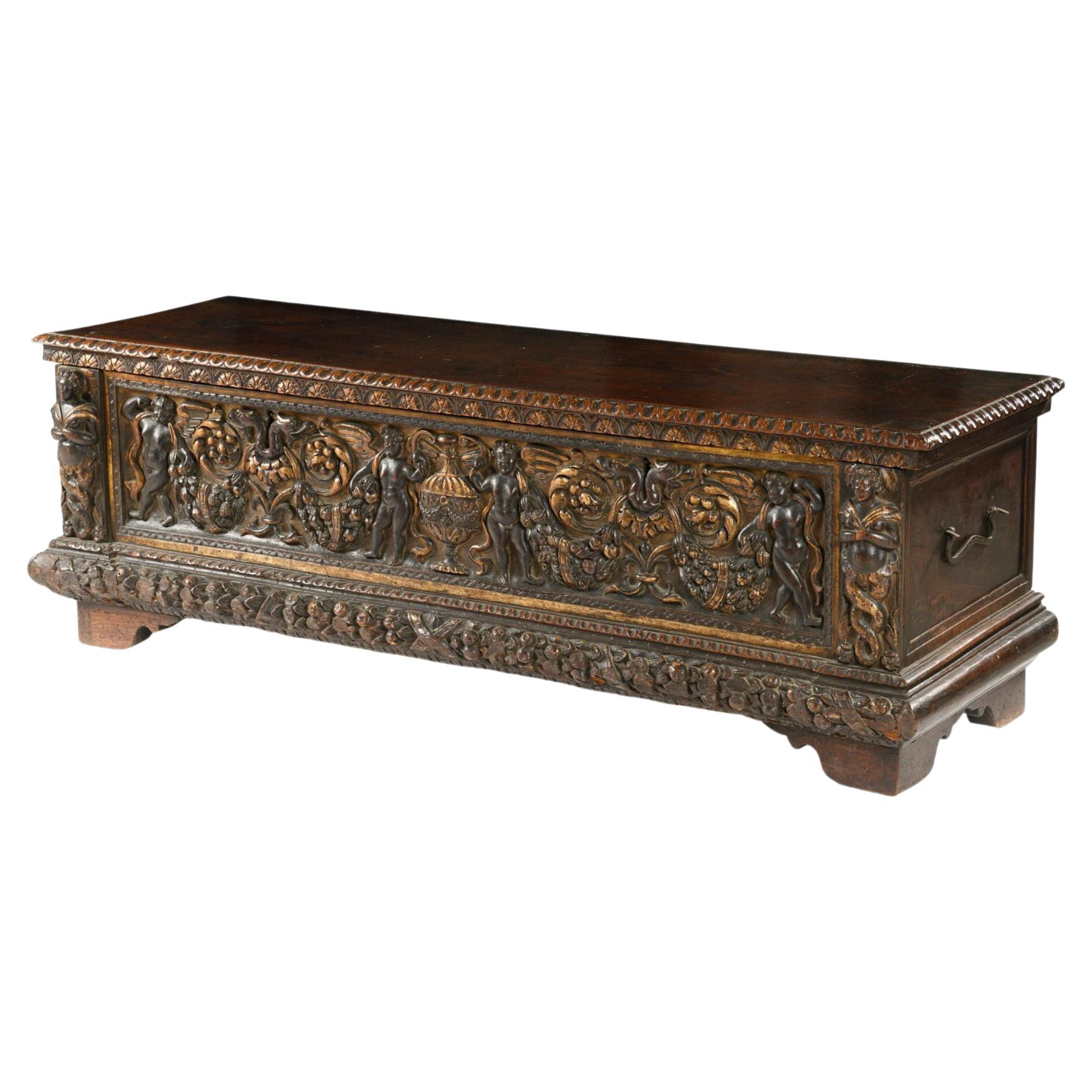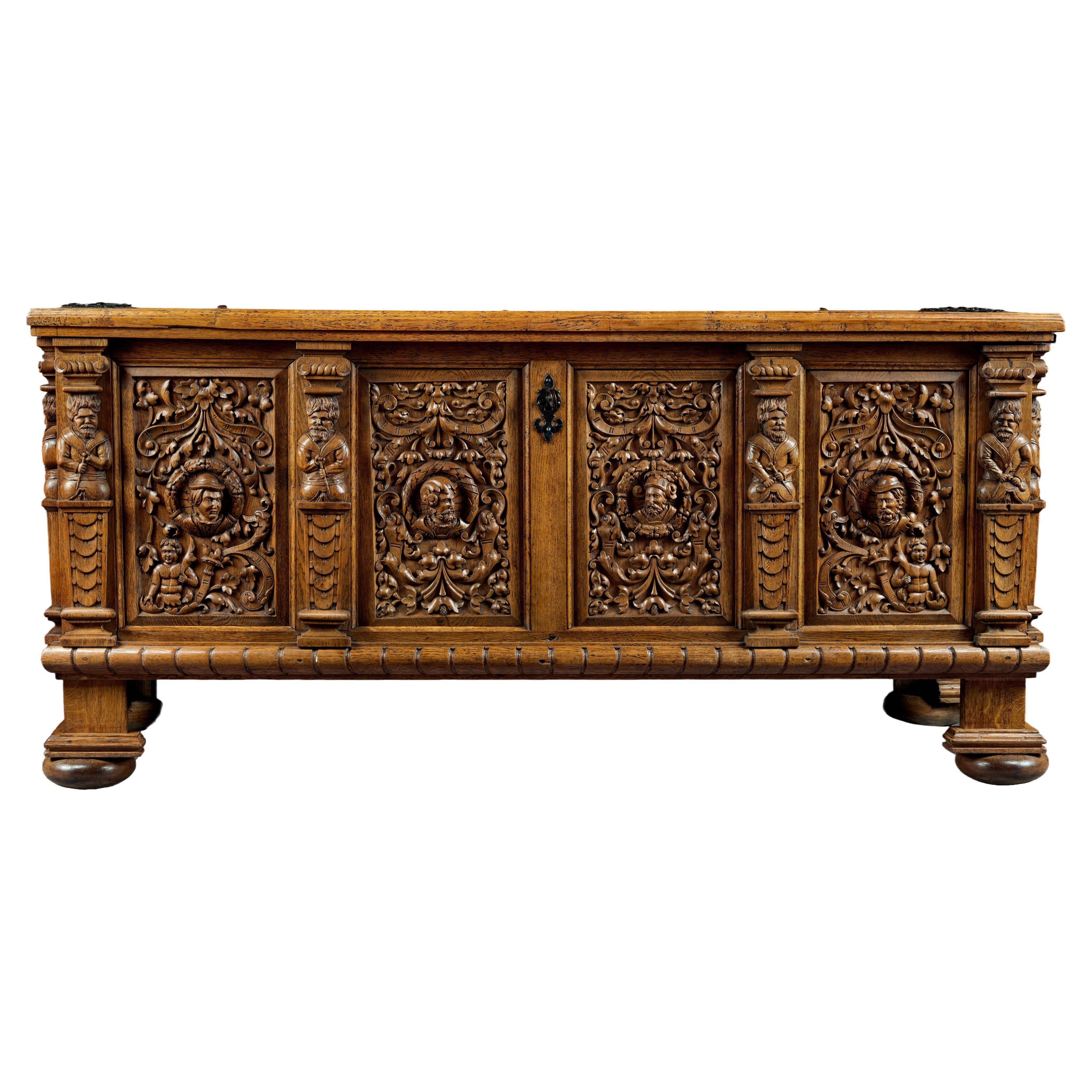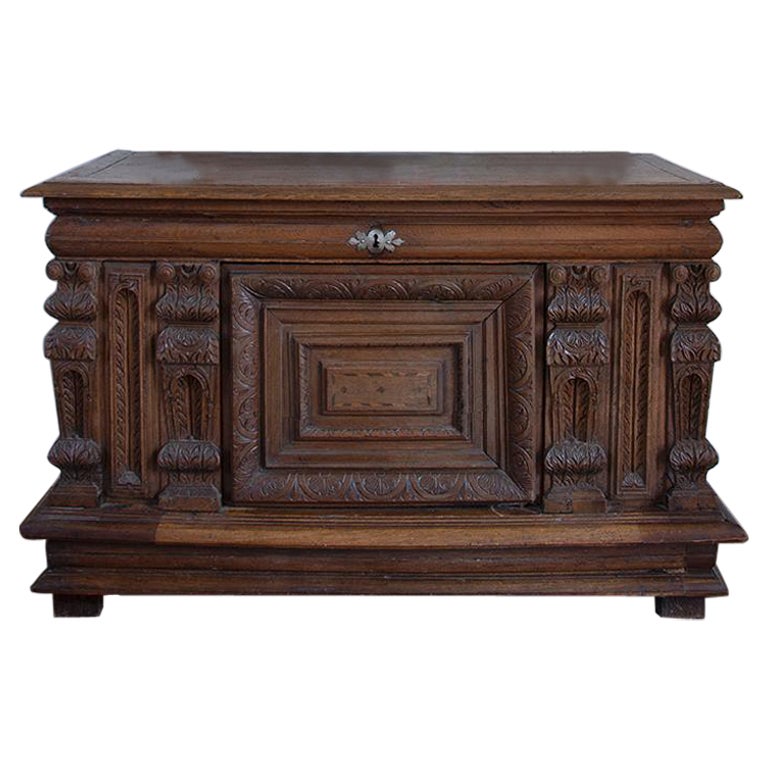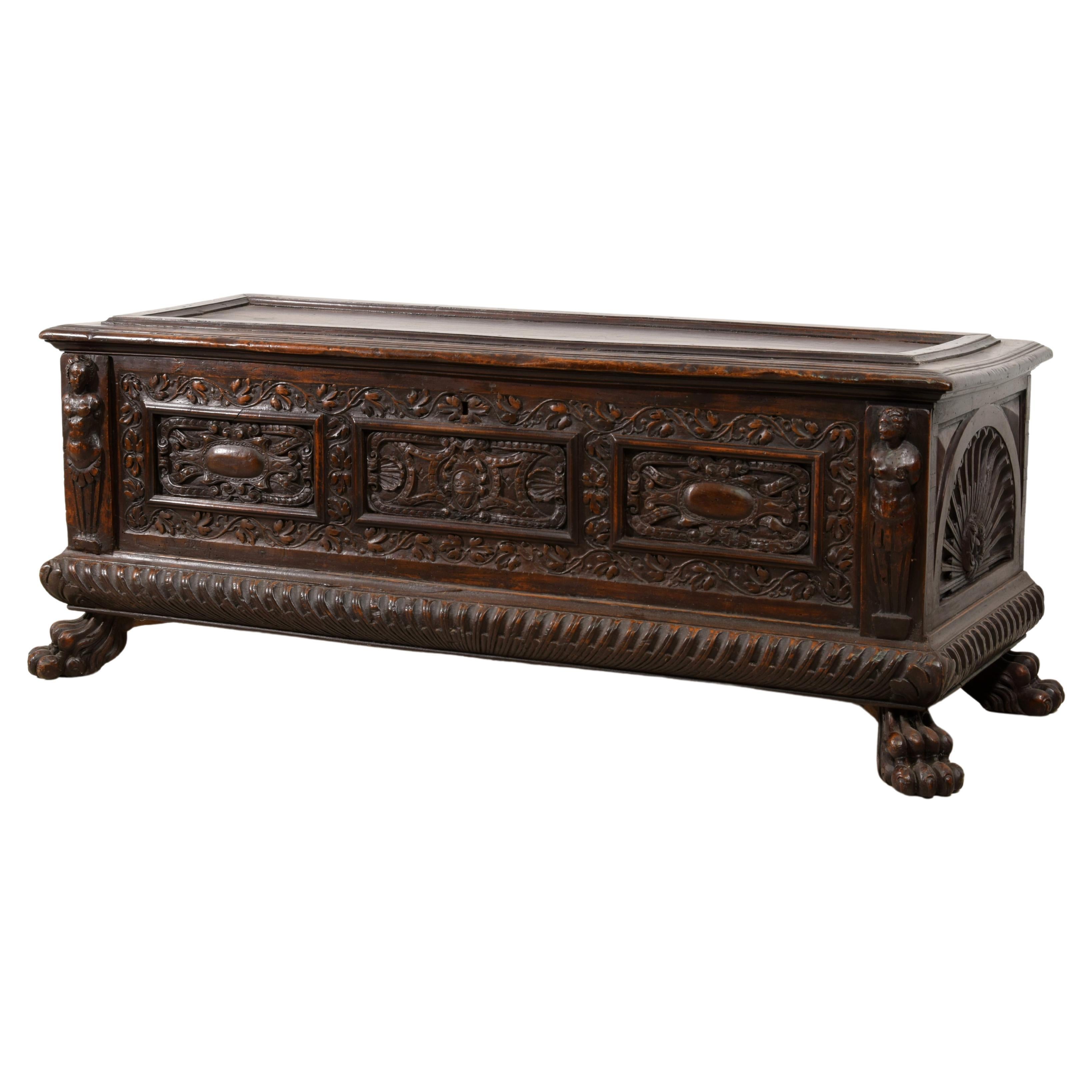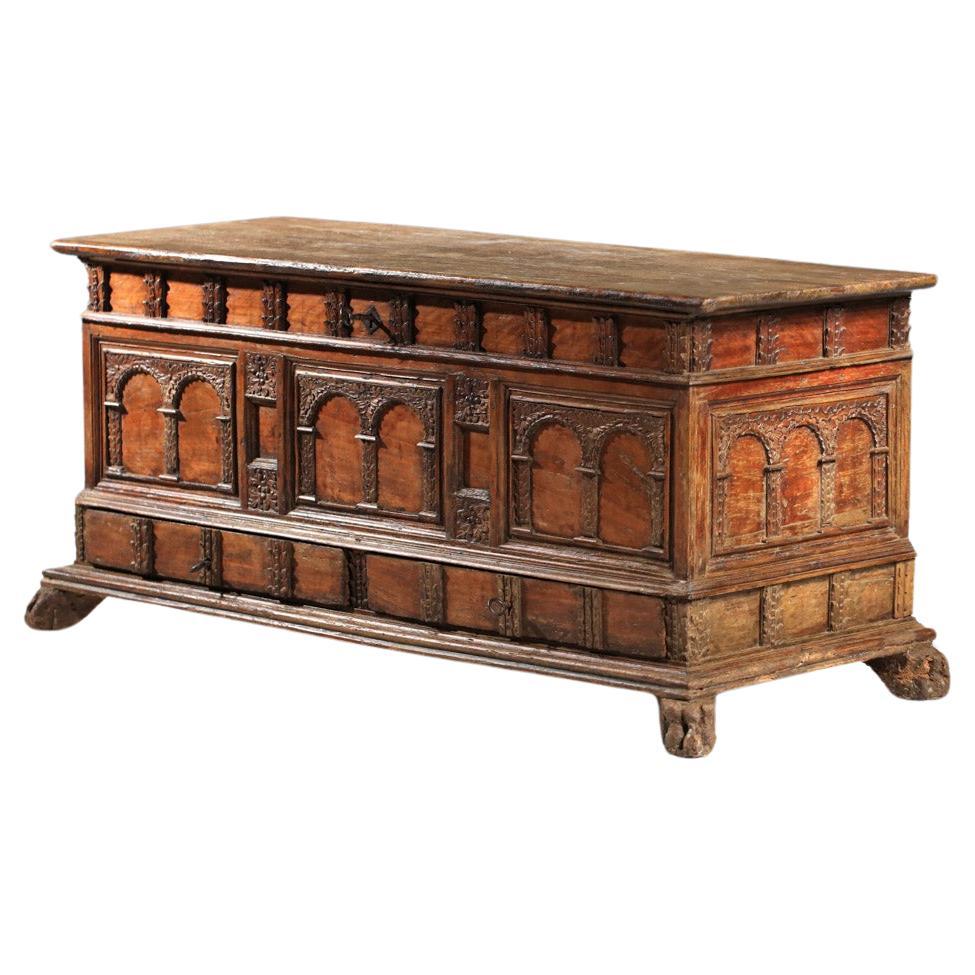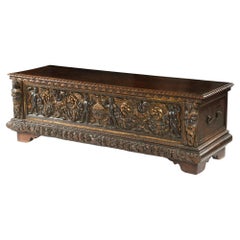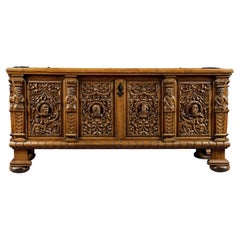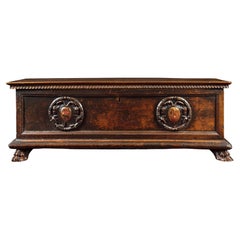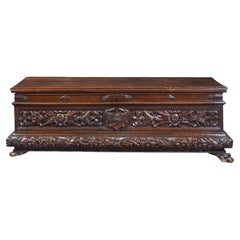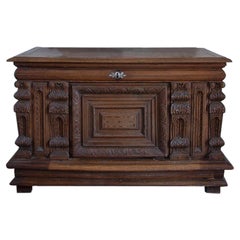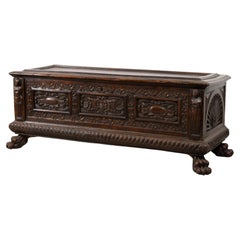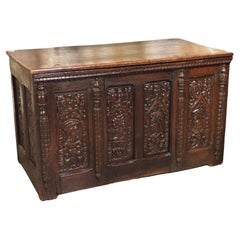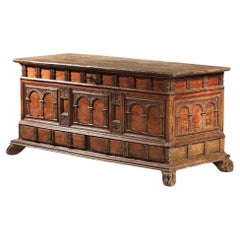Items Similar to Swiss Chest richly carved, Riedmatten family, framed by two Holy conversations
Want more images or videos?
Request additional images or videos from the seller
1 of 14
Swiss Chest richly carved, Riedmatten family, framed by two Holy conversations
$57,212.24
£42,363.77
€48,000
CA$78,675.41
A$87,494.67
CHF 45,799.42
MX$1,067,328.58
NOK 575,486.44
SEK 541,319.29
DKK 365,454.60
About the Item
SWISS CHEST RICHLY CARVED WITH THE COAT OF ARMS OF THE RIEDMATTEN FAMILY FRAMED BY TWO HOLY CONVERSATIONS
ORIGIN : SWITZERLAND, VALAIS CANTON
PERIOD : END OF 16th CENTURY – EARLY 17th CENTURY
DIMENSIONS :
Height : 80 cm
Width : 166 cm
Depth : 62 cm
Walnut Wood
Original Locks
Very Good State of Preservation
Chest with the Coat of Arms of the Riedmatten Family
The abundance of ornamentation is exalted in this Swiss Renaissance chest with harmonious proportions and generous decoration.
The facade is adorned with three panels framed by four youthful caryatids, draped in pilasters with interlacing motifs. Two Holy Conversations frame the central panel.
This central panel is adorned with a coat of arms consisting of a three-leaf clover topped with two stars, revealing the arms of the RIEDMATTEN Family from the Saint Gingolph branch. On each side of the coat of arms, intricate rocaille motifs emerge. Above, a young woman once held a clover and stands on a pot-shaped, openwork, flame-crowned pedestal, a motif appearing from the late 16th century onward.
On either side, a semi-circular vault bordered by high-relief moldings with semi-rosette motifs presents a scene of Holy Conversation to the viewer. Flowers and various fruit clusters embellish the spandrels.
The Holy Conversation, translated from Italian as "Sacra Conversazione," is a religious artistic theme that flourished from the 15th century in Northern Italy and Flanders, passing through Switzerland. It is not connected to biblical texts but consists of an extrapolation incorporating a prevalent theme, that of the Virgin in Majesty or a Virgin and Child, as represented here, usually surrounded by Saints and sometimes smaller donors.
On the left, an interior scene unfolds, framed by draped curtains. It is an animated, almost intimate scene, where characters interact. The Virgin, holding the infant Jesus in her arms, sits on a sculpted throne, architecturally structured and topped with a typically Renaissance canopy treated in antique style. The curly-haired Child stands on her knees.
Facing her, Saint Catherine of Alexandria, one of the patron saints of the Canton of Valais (with Saint Maurice and Saint Théodule), kneels in adoration. She holds the hand of the child, bowing before him with her beautiful hair.
She is represented here with her attributes, namely the crown, sword, and the toothed wheel of her martyrdom. A martyr of the 4th century, she refuses to marry the Roman emperor Maximin, who condemns her to the torture of the wheel. Both figures play with the Child, making the scene lively and joyful.
The scene on the right also represents a Holy Conversation. We find the Virgin and Child, and Saint John the Evangelist. This time, the scene takes place outdoors, in a lush enclosed garden with diverse plant species. In this bucolic atmosphere, rocks and a well are depicted in the background.
The Virgin is this time dressed in a veil that extends as an apron over her beautifully pleated dress. The infant Jesus, haloed and in an attitude of joy, presents a sheaf of roses and olive branches to the kneeling Saint John the Evangelist, in prayer. He is represented as a handsome young man with feminine features. Facing him, his attribute, a chalice from which a serpent escapes, symbolizes the trial of the poisoned cup or the triumph of faith.
Saint John the Evangelist represented with a chalice alludes to his testing by the high priest of the temple of Diana in Ephesus. The priest tells him, "If you want me to believe in your god, I will give you poison to drink, and if it does not harm you, then your god is the true God."
Saint John neutralizes the venom with a blessing gesture as it escapes from the chalice in the form of a small two-headed dragon. The legend tells that Saint John was then able to drink the potion.
This narrative, popularized by Jacques de Voragine's "Golden Legend," draws inspiration from phrases in the Gospels. In the Gospel of Matthew, Jesus says to Saint John and his brother, "Indeed, you will drink my cup." And in the Gospel of Mark, the resurrected Jesus sends the apostles on a mission and promises them, among other things, immunity against poison: "These signs will accompany those who have believed: in My name, they will cast out demons, they will speak with new tongues; they will pick up serpents, and if they drink any deadly poison, it will not hurt them" (Mark 16:17-18).
Saint John the Evangelist is known as the saint who opposed polytheistic cults. Consider this statement of Jesus to Nicodemus: "And as Moses lifted up the serpent in the wilderness, even so must the Son of Man be lifted up, that whoever believes in Him should not perish but have eternal life" (John 3:14-15).
Elaborately worked, the sides of the chest are not neglected. Two large wrought-iron handles adorn the center of a panel covered with scrollwork blossoming with beautiful ivy and olive leaves.
As is customary on Swiss chests, the hinged lid, crowned with a lovely frieze of semi-rosettes, houses a finely wrought and chiseled wrought-iron lock. The hinges joining the back and lid of the furniture are also worked and chiseled, worthy of Swiss workshops already renowned at the time.
The Base
The chest, whose lower border features a frieze of braided leaves surmounted by a second one with semi-rosettes, rests on two lion's paw claws at the front and two double-flattened ball feet at the back.
This chest, admirably designed and sculpted in various ways in light and deep relief, sometimes in openwork up to the round of the hump, offers richness in terms of subjects, decorations, and ornamentation.
Bibliography :
Armorial valaisan : Walliser Wappenbuch / hrsg. vom Kantonsarchiv = Walliser Wappenbuch, Archives cantonales (Valais), Zurich : Orell Fuessli, 1946.
Morend, Jean-Claude ; Dupont Lachenal, Léon, Nouvel armorial valaisan. : Neues Walliser Wappenbuch, Saint-Maurice : Ed. du Scex, 1974.
Please ask for additional documentation
- Dimensions:Height: 31.5 in (80 cm)Width: 65.36 in (166 cm)Depth: 24.41 in (62 cm)
- Style:Renaissance (Of the Period)
- Materials and Techniques:
- Place of Origin:
- Period:
- Date of Manufacture:1580 - 1620
- Condition:Wear consistent with age and use.
- Seller Location:Saint-Ouen, FR
- Reference Number:Seller: 3361stDibs: LU3115341305312
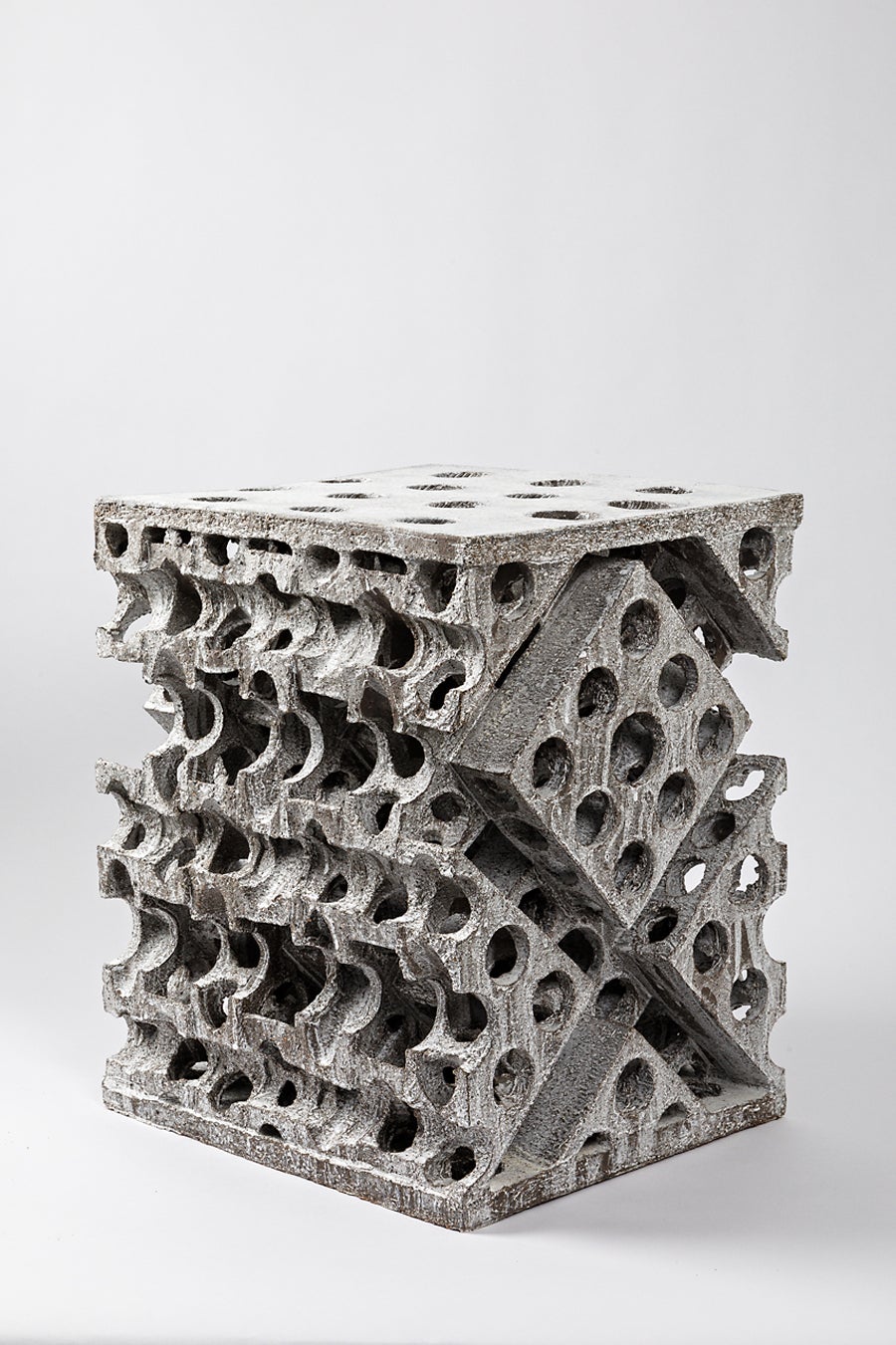
About the Seller
5.0
Vetted Professional Seller
Every seller passes strict standards for authenticity and reliability
Established in 2016
1stDibs seller since 2017
193 sales on 1stDibs
Typical response time: 1 hour
- ShippingRetrieving quote...Shipping from: Paris, France
- Return Policy
Authenticity Guarantee
In the unlikely event there’s an issue with an item’s authenticity, contact us within 1 year for a full refund. DetailsMoney-Back Guarantee
If your item is not as described, is damaged in transit, or does not arrive, contact us within 7 days for a full refund. Details24-Hour Cancellation
You have a 24-hour grace period in which to reconsider your purchase, with no questions asked.Vetted Professional Sellers
Our world-class sellers must adhere to strict standards for service and quality, maintaining the integrity of our listings.Price-Match Guarantee
If you find that a seller listed the same item for a lower price elsewhere, we’ll match it.Trusted Global Delivery
Our best-in-class carrier network provides specialized shipping options worldwide, including custom delivery.More From This Seller
View AllExceptional Italian Renaissance Cassone with Rich Carving on a Gilt Background
Located in Saint-Ouen, FR
The lower part of the facade is adorned with a foliated and fruit garland.
The facade’s central panel bears a low-relief decor framed by a rais-de-cœur frieze. The central scene a...
Category
Antique 16th Century Italian Renaissance Blanket Chests
Materials
Walnut
Rare and Important German Renaissance Chest
Located in Saint-Ouen, FR
Oakwood
Original lock and key
This beautiful and robust chest stands on square feet ending in flattened buns. The base presents plain mouldings. The facade is divided in four panel...
Category
Antique 16th Century German Renaissance Blanket Chests
Materials
Wood, Walnut
Carved Tuscan Wedding Cassone, Renaissance Period
Located in Saint-Ouen, FR
This cassone, remarkable for its sobriety, sits on two clawed lion’s feet and a moulded base.
On the façade, there is one large, moulded frame, with two soberly carved medallions inside it. Each medallion has a painted coat of arms at the centre. The two coats of arms are different, suggesting that there was an alliance between two families through marriage.
The thick lid has a fluted frieze at the front.
On the sides, a wrought iron handle reminds us of the use of this piece, which was intended for storing the property of its owner and allowing them to travel between various residences. The square shaped handles highlight the earliness of this object in the century.
The cassone is, along with the bed, a key piece of furniture of the Middle Ages and was still used in the Renaissance Period.
Category
Antique 16th Century Italian Renaissance Blanket Chests
Materials
Walnut
Italian Renaissance Cassone with the Coat of Arms of the Bonfanti Family
Located in Saint-Ouen, FR
This Italian walnut chest called « cassone » is shaped as an antic sarcophagus. The beautiful patina and the plain lid bring to the fore the facade richly ornated with vegetal motifs...
Category
Antique 16th Century Italian Renaissance Blanket Chests
Materials
Walnut
Large 16th Century Tuscan Wedding Chest Called "Cassone"
Located in Saint-Ouen, FR
Large wedding chest in tinted and gilded walnut, the lid animated with a frieze of pearls, the sides with compartments, the belt decorated with gadroons. It rests on four claw feets.
Category
Antique 16th Century Italian Renaissance Blanket Chests
Materials
Walnut
Spanish Chest with Arcade design
Located in Saint-Ouen, FR
SPANISH CHEST WITH ARCADE DESIGN
ORIGIN: SPAIN
PERIOD: LATE 15TH – EARLY 16TH CENTURY
DIMENSIONS:
Height: 61 cm
Length: 135 cm
Depth: 48 cm
Chestnut wood
Good condition
This H...
Category
Antique 16th Century Spanish Gothic Blanket Chests
Materials
Wood, Chestnut
You May Also Like
Renaissance Period French Hand Carved Chest / Trunk - 17th - France
Located in Beuzevillette, FR
Very beautiful trunk from the Renaissance period, very nicely carved with palm leaves and acanthus leaves in an architectural setting. Four Ionic co...
Category
Antique 17th Century French Renaissance Blanket Chests
Materials
Wood
XVI Century, Italian Renaissance Wood Chest
Located in IT
XVI Century, Italian Renaissance wood chest.
This important noble chest of the Tuscan Renaissance was built towards the end of the sixteenth centur...
Category
Antique 16th Century Italian Renaissance Blanket Chests
Materials
Nutwood
$19,666 Sale Price
25% Off
16th Century French Renaissance Chest in Carved Oak
Located in Dallas, TX
Whereas many pieces of furniture during the Italian Renaissance were heavily painted or inlaid with decorative motifs, French examples utilized hand-sculpted elements as the predomin...
Category
Antique 16th Century French Renaissance Blanket Chests
Materials
Wood, Oak
17th century Spanish or Italian carved solid wood chest
Located in Ternay, Auvergne-Rhône-Alpes
Spanish or Italian 17th century bis chest.
Chest structure in solid walnut, entirely hand-carved. Exceptional craftsmanship.
Very naive vintage conduction with a nice patina on the...
Category
Antique 17th Century Italian Gothic Blanket Chests
Materials
Walnut
Antique 17th Century Italian Cassone Wedding Chest with Hand-Carved Detailing
Located in Madrid, ES
The cassone (plural "cassoni") was a large decorated wooden chest, primarily made in Italy. Cassoni were traditionally given to a bride by her parents, and were often placed at the f...
Category
Antique 17th Century Italian Rustic Blanket Chests
Materials
Wrought Iron
17th Century Northern France Wedding Chest in Carved Oak
Located in Dallas, TX
Based on the facing portrait cartouches on the front facade, this chest was most likely presented to a couple for their wedding in 17th-century Northern France. The oak wood has a deep brown patina that accentuates the hand-carved frontage, depicting a man (on the left) facing a woman (on the right), surrounded by scrolls and a sprawling foliate margent. A quarter-round edge embellishes the lid, which can be opened to reveal deep storage, including a 5 ½ inch tall side compartment. Several thin layers of molding can be seen on the low profile apron above small bracket feet.
A chest like this would have been offered as a wedding dowry, most likely commissioned by the parents of the bride or possibly even by the husband himself. The chest would have been used to store valuables for the couple’s new life together, with the wrought iron handles on the sides allowing the chest to be easily transported. Our 17th-century wedding chest can be used functionally as a small storage chest for a bedroom or bathroom or displayed as a well-carved room...
Category
Antique 17th Century French Blanket Chests
Materials
Metal, Wrought Iron
More Ways To Browse
Conversation Furniture
Family Arms
Antique Carved Chest
Carved Wood Chest
Carved Wood Storage Chest
Hand Carved Antique Chest
Flower Chest
Chest On Frame
Light Wood Chest
Italian Carved Chest
Carved Pilaster
Antique Carved Wood Molding
Two Over Three Chest
Side Lock Chest
Framed Coat Of Arms
Swiss Walnut
Carved Jesus
Lion Chest
